Ub Iwerks/MGM (1930-1933), Thunderbean (November, 2023), 2 Discs, 284 mins, 4:3 ratio, Dolby Digital 2.0 Mono, Not Rated, Retail: $38.95
Storyboard:
The first star character from Ub Iwerks’ own studio faces numerous challenges in the country and the city, as he makes his way through the Depression years.
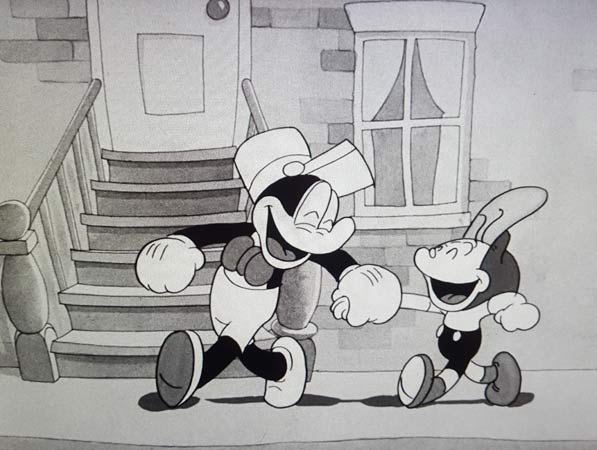
The Sweatbox Review:
My initial exposure to Flip the Frog came in late 1993, via my first purchase from the Whole Toon Catalog. (That would be mail order, kids.) I was enjoying my time living away from home after university, and was starting to enthusiastically indulge my love of animation in any way that I could. Somehow, I had discovered the wonderful, stupendous, revelatory Whole Toon Catalog, stuffed full of an amazing array of books and videos about cartoons. It was through the WTC that I found Leonard Maltin’s landmark book Of Mice And Men, which I devoured; that book had a short but illuminating chapter on the Ub Iwerks studio. The Catalog also introduced me to Bosko Video, who made VHS tapes of vintage animated cartoons. From the Catalog, I purchased Bosko’s tapes of the Fleischer Superman cartoons, as well as Van Beuren’s The Little King, Tom and Jerry (what, a couple of humans?!?), and Cubby Bear – man, what discoveries these all were! And, at the beginning of those tapes played an advertisement for more Bosko tapes, featuring a cartoon “star” that I had never heard of, a piano-playing amphibian named Flip the Frog! I was intrigued. I didn’t actually order the Flip tapes done by Bosko (sorry!), as I instead chose to go with the Cartoons That Time Forgot series of tapes (later upgraded to laserdisc and DVD); one volume of that series was entitled, Down And Out With Flip The Frog. Back then, any rare cartoons were thrilling to see, and I greatly enjoyed meeting that little froggy and seeing what he was all about. Years later, it is with great satisfaction that I now own a high-definition set of the complete Flip series, thanks to Thunderbean – that little operation based out of Michigan and run by cartoon mensch Steve Stanchfield.
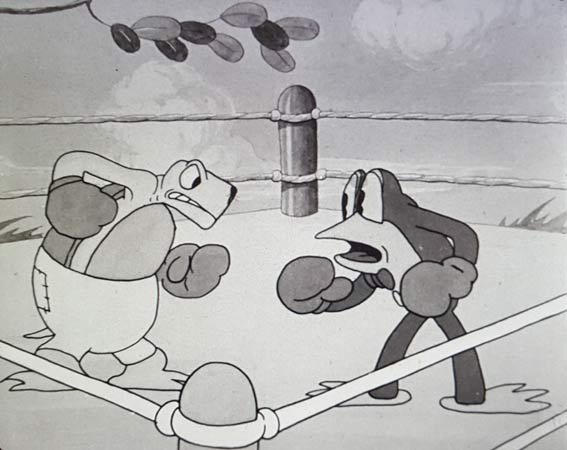
But who is Flip the Frog? Forgive me if you’ve heard this before, but… in some ways, it all started with a mouse…
Mickey Mouse became an immediate sensation in 1928 with the release of Steamboat Willie. Producer Walt Disney was given much of the applause, but right from the beginning, another man was credited on the title card, in letters just as big as those in Walt’s name. That card read, “A Walt Disney Comic by Ub Iwerks.” Ub was a colleague of Walt’s from Kansas City, and he was Disney’s main animator on the early Mickey Mouse cartoons, as well as the Silly Symphonies series. Ub stayed with Disney’s California company for six years, beginning in 1924, and was therefore witness to all the highs and lows of Walt’s first few years in Hollywood. Ub was amazingly fast, doing hundreds of drawings per day. Legend has it that he animated Mickey Mouse’s first produced cartoon, Plane Crazy, all by himself in just two weeks. Other animators considered him a genius, not just for his speed, but also for his innate sense of movement and perspective. He was obviously a highly valued member of the Disney staff.

However, Walt and Ub did have disagreements, and that may have led to Ub accepting a 1930 offer from Walt’s own distributor, Pat Powers, to finance a studio to be run by Ub. Iwerks was the same age as Walt; amazingly, considering what they had each accomplished already, they were only 28 years old in 1930. At that tender age, following somewhat in Walt’s mighty footsteps, Ub put together a studio, hiring artists who answered a newspaper ad. He designed a new character, Flip the Frog. The initial design was indeed frog-like, with gangly limbs and webbed toes, and a head that melted into his chest. Iwerks made a pilot film called Fiddlesticks, using a double separation negative method called Harriscolor, a 1929 invention of one J.B. Harris, Jr. That color format never evolved past the experimental stage, so it is fascinating to see that first Flip cartoon now, and understand that this was a rare use of an early color system. (Notably, the first Disney color short was Flowers And Trees, which was made – with great publicity – two years later.)
Fiddlesticks and the next few shorts were initially distributed by Powers’ own company, Celebrity Productions. Fiddlesticks showed off exacting synchronization of sound and picture, using the system that Ub had largely developed himself while working with Disney. Fiddlesticks did not have much of a story, though, simply showing Flip among other denizens of the outdoors, dancing and frolicking about in a woodland environment. He does a jig to the tune of Sailor’s Hornpipe, which would soon also appear in numerous Popeye cartoons. Flip plays piano as well, accompanied on violin by a mouse that undoubtedly reminds one of Mickey, though in a skirt rather than shorts. (The skirt is red, too, though Mickey was still appearing in monochrome in his own cartoons at that time.)
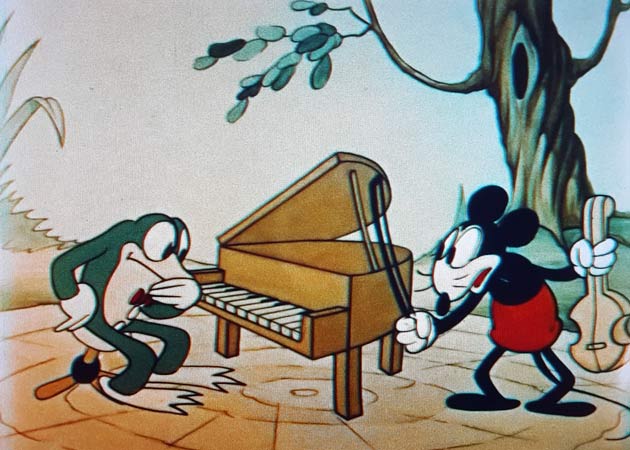
The next few Flip shorts were also done in color, according to this set’s liner notes, but Fiddlesticks is the only one to survive in color. The next short was Flying Fists, a boxing cartoon. Then, in Little Orphan Willie, in which Flip adopts a baby mouse, Flip began his metamorphosis, gaining gloves, shorts, and shoes – familiar attire for certain cartoon characters of the day. After that came Puddle Pranks, where Carl Stalling gave Flip a theme song that accompanied each of his cartoons from then on. It was during production of this cartoon that a deal was being worked out with MGM, so Puddle Pranks exists with title cards for both Celebrity Productions, Inc. and MGM. Both versions appear on the disc. Ironically, MGM never released Puddle Pranks, and that cartoon had to wait for Powers to release the Celebrity version once the MGM deal was over.

Thus, it was after a few shorts were produced that Powers was able to sell the package to MGM, becoming that revered studio’s first supplier of animated films. The security offered by the MGM contract also meant new hires for the studio. That included another Kansas City colleague, aforementioned music director Carl Stalling; Stalling was hired away from Disney, this being a few years before his long stint at the Leon Schlesinger studio. The studio’s other composer was Scott Bradley, who later did superlative work directly for MGM’s cartoon unit. New artists at Iwerks’ included Grim Natwick, Rudy Zamora, Irv Spece, and Shamus Culhane. Even Chuck Jones had a small role at the studio. The first new Flip cartoon under the MGM deal was The Village Barber, which gained Flip by far his biggest exposure yet. Fortunately, it is a cartoon with strong gags, as Flip moves from the woods to a city setting, where he manages a barber shop.
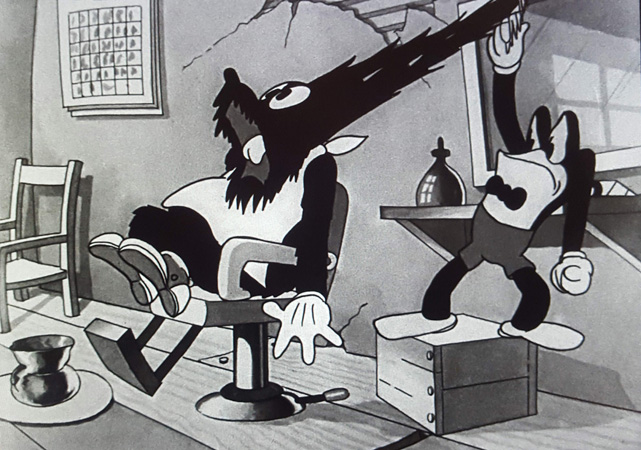
At this point, Flip is finally really up and running. His next cartoons have him as a detective investigating a murder, taking on various positions at a restaurant, working as a blacksmith, and then as a dentist, before wooing his feline girlfriend in Ragtime Romeo. The cartoons still basically follow the “music & gags” model, like many cartoons of the day, but they do contain many technical flourishes (e.g. an animated sidewalk moving in perspective, lighting tricks, etc.) to support the bare narratives.
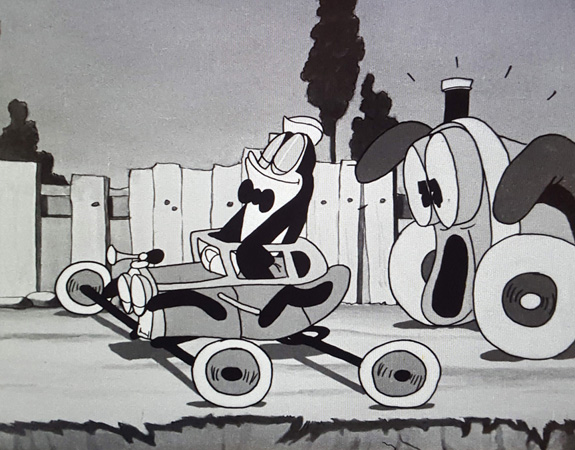
MGM encouraged Powers to ask Iwerks to make Flip more anthropomorphic, to add to his relatability. Thus, Flip eventually got a rounded head and more human proportions. His new look evolved over time, but is largely seen by the time of The New Car. Flip is more visually appealing by this point, though he remained in search of a distinguishable personality. The cartoons were still largely devoid of speaking, with occasional exceptions. When Flip did speak, he originally spoke with a falsetto reminiscent of Mickey Mouse. When he sang, however, such as in the cartoon openings, his voice was somewhat deeper. He sometimes lost the falsetto in the stories, but his voice remained inconsistent and nondescript. In the absence of a memorable voice like Donald Duck or Goofy, Flip’s personality was stifled. It’s perplexing, given all the other attention paid to sound in these cartoons. Still, the shorts had their good points. Stormy Seas followed, with lovely effects animation, and a wonderful Neptune animated by Grim Natwick.
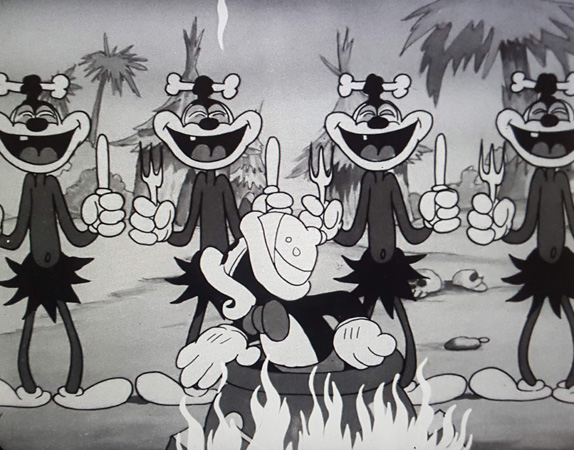
However, the cartoons continued to squander good story ideas by failing to give us a character to root for. As Flip breaks into a film studio, fails as a plumber, hunts in Africa (beware some racist caricatures in this one!), encounters Spooks, and works as a firefighter and a milkman, we do get entertained by the increasingly polished visuals, well-realized gags, and zippy music; but the cartoons just don’t quite ascend to the next step of excellence relative to what audiences were seeing from Disney and Fleischer, and soon would see from Warner Bros. and Universal.
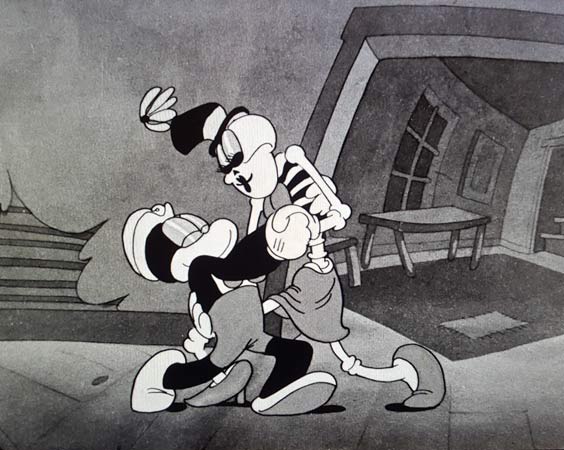
Nevertheless, I enjoyed every minute of watching these cartoons, and things got even better when moving on to the second disc. Here, the cartoons grow up, perhaps reflecting more the personalities and concerns of the crew that had moved to the studio from New York. The cartoons get a slightly harder edge, gain social consciousness, and become more reflective of Depression-era society. What A Life, for example, sees Flip and his young friend scrimping for change and struggling to get fed. However, audiences didn’t have to worry about the cartoons staying too serious, as evidenced by the cute dog vs. dogcatcher story in the following cartoon, Puppy Love. This cartoon also comes in an alternate European version, with changed music and dialog, which is also included on the disc.
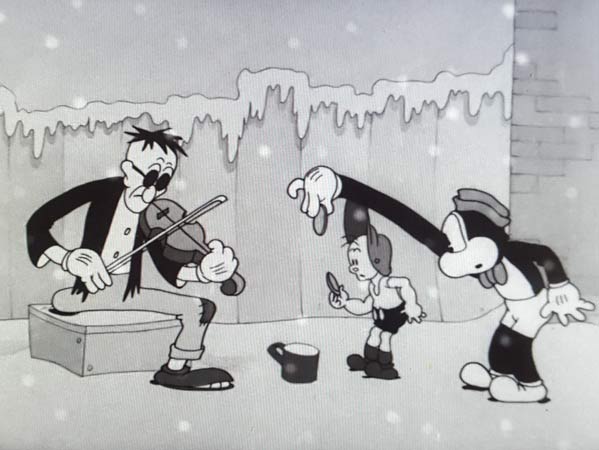
Flip was picking up a bit of a recurring cast by this point. His girlfriend had evolved from a fellow frog to a dog (and soon a human), and his stories had gained a horse, a dog, a little boy, and an “old maid” character. This broadened things out, though unfortunately the issue of lacking personalities remained, aside from someone being happy or cranky or in love.
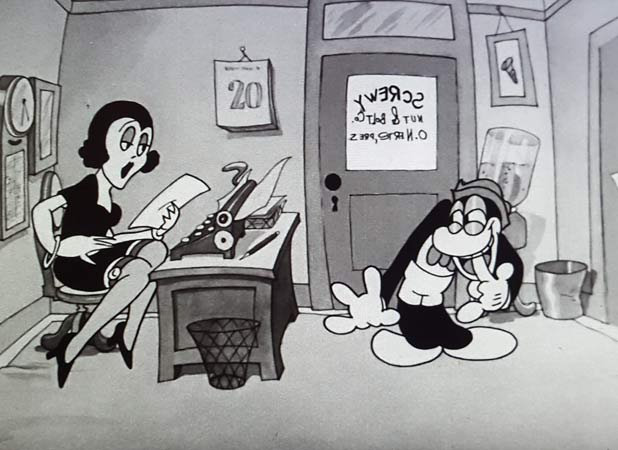
After a couple of cartoons where Flip was portrayed as being younger, he grew up enough to be hired as The Office Boy, a short that also featured a curvy secretary who had trouble keeping her clothes intact, making this (and the next one) the raciest of the Flips. There are more Natwick-animated lovely ladies in Room Runners, which sees Flip trying to get out of his hotel bill. The pre-Code nature of these cartoons is in further evidence in Circus; what could have been a pretty standard cartoon gets some spice with a sequence in which the old maid gets, um, felt by both Flip and a pickpocket, not all of which is unpleasing to her. A few seconds of this sequence were originally cut from prints, but that footage was found and is restored here – in slightly lesser quality from the rest of the cartoon. A football cartoon follows, then the rather amorous old maid returns for the fun western spoof The Pony Express.
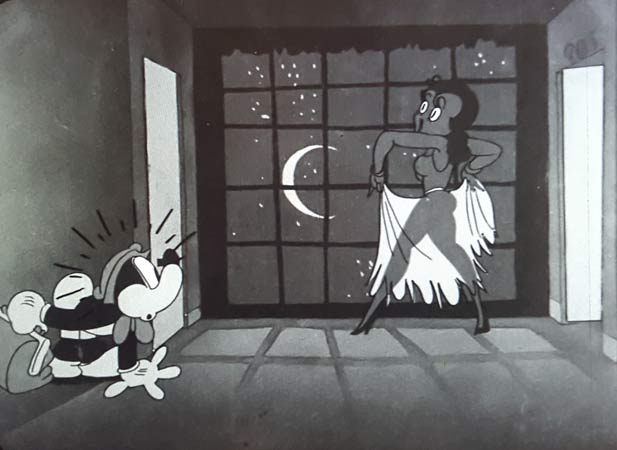
Flip reverts to boyhood in The Music Lesson, then becomes a babysitter in Nurse Maid, before we get to one of his more well-known and unique cartoons: Funny Face. Here, Flip sees a plastic surgeon to help him look more human, and therefore attract the affections of a girl. The disc contains two versions of this cartoon, with different versions of the girl. One version is designed to have greater similarity to Betty Boop, whom Natwick worked on in the Fleischer cartoons. Next up is the Arabian adventure Coo-Coo The Magician, complete with harem girls. It is in this cartoon that the new Flip design is finally incorporated in the opening of the short, with Flip singing at the piano.

The last few cartoons see Flip once again working in a kitchen, inventing a robot to cut his grass, becoming a bullfighter in a truly looney bullring, returning to being a cop (with more racial imagery abounding in A Chinaman’s Chance), and trying his luck as a pioneer, only to face warring native Americans in Pale Face (naturally, some may also find those depictions somewhat unfortunate, to say the least). In terms of all those racial caricatures, let us keep in mind that they were common in cartoons back then; that does not excuse them, but it does put them in context with the times. Warnings about this appear at the back of the booklet and at the beginning of the discs.
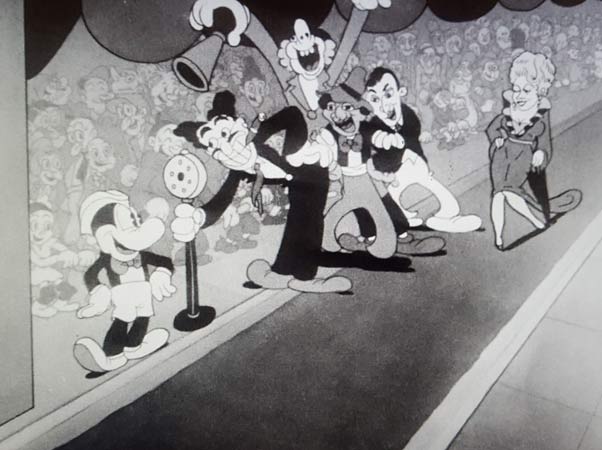
Racial caricatures aside, Flip was picking up steam… just in time for his cartoon series to get cancelled! But there was one more short to go, and it is certainly my favorite: The Soda Squirt. When I first saw that Flip ad at the beginning of those Bokso Video tapes, that ad heavily featured The Soda Squirt and its music. I love The Soda Squirt, though, for more than sentimental reasons. The short also features several wonderful celebrity caricatures, including the Marx Brothers and Mae West, all attending his drug store soda shop. The short has some great synchronized movement, set to the best music score of the series. Flip would be done after this cartoon, but he went out with a bang. Given that trajectory, it is a shame that it was decided that Flip had had his chance already.
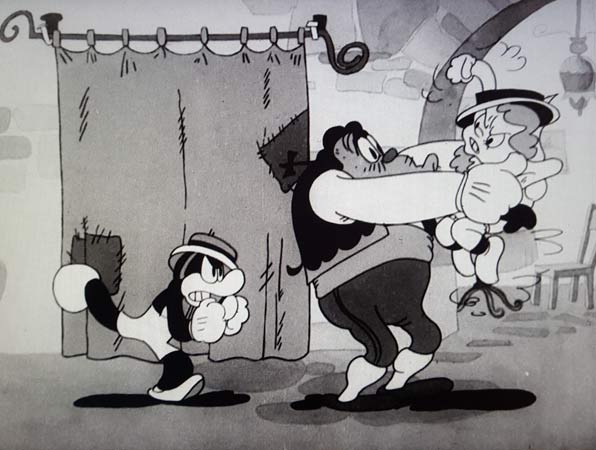
Despite all the talent at the Iwerks studio, Flip never really took off. A respectable 38 shorts were produced, and there was certainly a fine promotional push for them, but neither MGM or theatre crowds were excited about them. The conventional line is that the Flip cartoons had nothing new to offer. He was simply an “everyfrog”, doing everyday things (more or less), in a not particularly clever or amusing way. And even when the cartoons had moments of brilliant animation or effects, and even occasionally a more gripping or entertaining storyline, the characterization fell short. However, the Flip shorts do certainly have a charm to them, even if that is now enhanced by the “retro” appreciation of all that rubber-hosed, bouncy, black and white animation. As one views this two-disc set, it can be seen that, as the series progressed, the shorts became better realized and more polished. Boring farmyard or nature-based antics gave way to more urban adventures, and other genres were explored. The storytelling got stronger, and the gags funnier. Yet, they never fully competed with Disney or Fleischer. Over at the Schlesinger studio, they were just warming up, as they introduced Porky Pig in 1936, and went on to develop an amazing cast of characters, each with well-defined personalities and voices. The Iwerks studio never got there. Ub was a genius in many ways, but he didn’t have the same storytelling spark, or the same knack for shaping characters into commercial hits, as his friend Walt.

Flip only lasted a few years before giving way to Willie Whopper in 1933. Willie was a chubby kid who told tall tales, opening up the storytelling to be more fanciful. (Thunderbean has produced a restored collection of those shorts, as well, released a few years ago.) Willie lasted about a year with MGM. Ub also did a Cinecolor series called Comicolor Cartoons, which were distributed by Powers himself, as MGM had no involvement. The Comicolors were the most striking cartoons to come out of the Iwerks shop yet, but they continued to use bland characters and largely humdrum storytelling. By 1936, the studio ran out of steam and closed.

After the studio shut down, both Iwerks and Stalling went to work for Leon Schlesinger. While Stalling stayed on for a legendary career scoring Looney Tunes and Merrie Melodies shorts, Iwerks had only a brief stint doing a couple of Porky Pig cartoons for Schlesinger. Iwerks then went to Columbia Pictures’ Screen Gems to direct Color Rhapsody shorts, before returning to Disney in 1940. This time, however, he focused his genius on the technical side, creating special visual effects and doing some remarkable inventing. His work in combining live action and animation, pioneering Xerography, and as an early theme park Imagineer made him an extraordinarily valuable Disney employee once again. His career there lasted decades, and was legendary.

Thunderbean, in association with Blackhawk Films and Film Preservation Associates (owned by the late David Shepard, who passed away during the production of this set), has done fans and animation history a great service. This set was in the works for several years, facing numerous challenges – including the global pandemic, which shut down film archives for a while. Nevertheless, the best possible elements were eventually gathered to produce this set, and the cartoons were painstakingly restored. This complete set of Flip the Frog cartoons is a supreme achievement for Thunderbean, and is – more importantly – a fitting tribute to the talents and genius of Ub Iwerks.
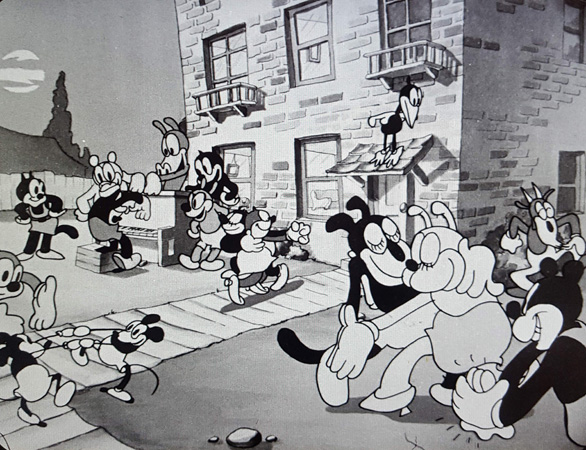
Is This Thing Loaded?
The cartoons appear on two discs, and each disc is loaded with superb bonus content.

Disc One
When these discs were being produced, there was a long wait at the end for a mysterious final piece. Fans were assured online that this piece would be essential, and later it was hinted that it had something to do with the Iwerks family. After several months of waiting, that piece turned out to be a Leslie Iwerks Introduction (2:21), a most welcome appreciation by the granddaughter of Ub Iwerks. Ms. Iwerks, a filmmaker herself, discusses the legacy of Ub, and sets the stage for our historical and creative appreciation of these films.

The Audio Commentary Tracks number twelve on disc one, and six on Disc Two, by such experts as David Gerstein, Devon Baxter, Thad Komorowski, J.B. Kaufman. Mark Kausler, Leonard Maltin, Jerry Beck, Thunderbean head man Steve Stanchfield, and others.
The Fire Fire Reconstructed Storyboard Reel (7:02) offers a rare and fascinating glimpse at the development of that short.

The Behind the Scenes Gallery includes character studies, model sheets, story outlines, animation drawings, copyright synopses, and more. Each set of images has clear, written descriptions of what the viewer is seeing. It’s a stellar presentation.
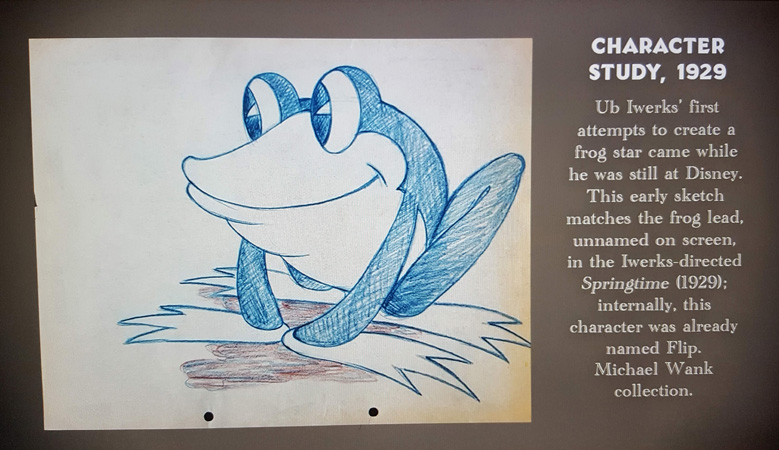
Theatrical Leaders (2:12) is a unique look at pre-title cards from the original 35mm films.
Flip The Frog Annual is a presentation of the original UK hardback book, which had numerous stories of Flip and friends. After describing the origins of the book, the disc allows the reader to select from one of fifteen stories to read. That’s right – Thunderbean didn’t just give us an image of the book’s cover and call it a day; they actually scanned dozens of pages of stories for us to read.
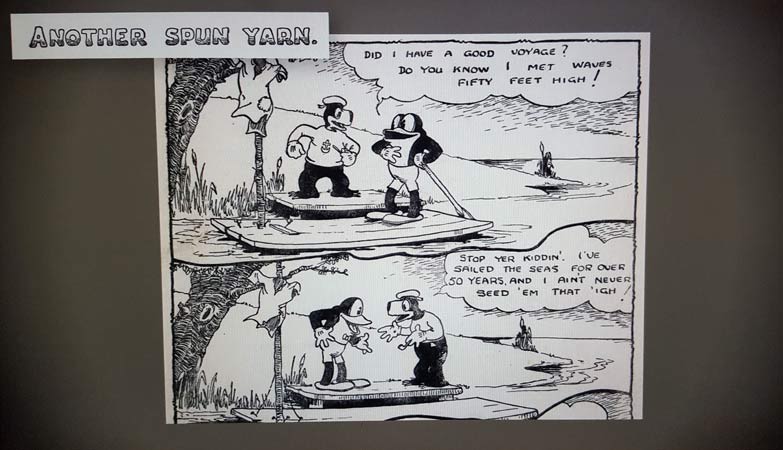
The Frog Songbook brings us numerous original recordings of songs that were later used in the Flip cartoons. Titles include “The Bulldog On The Bank”, “Bull Frog Blues”, “By Heck”, and several more. These recordings date back to the 1910s and 1920s, so their inclusion here is most interesting.
Flip la Grenouille, Le Cine-Concert shows a performance by a musical group that played live music to accompany Flip the Frog films as they toured France in 2016 and beyond. The full cartoon Spooks (8:37) is presented with their accompaniment, along with excerpts from Techno-Cracked (2:53) (this time showing the musicians as well as the cartoon), and a teaser is also presented.

Disc Two
A Publicity and Merchandise Gallery features dozens (or was it hundreds?) of images, including newspaper clippings, exhibitor reviews, trade paper ads, licensed toys and videos, and more. Finally, I got to see the Bosko Video VHS covers!
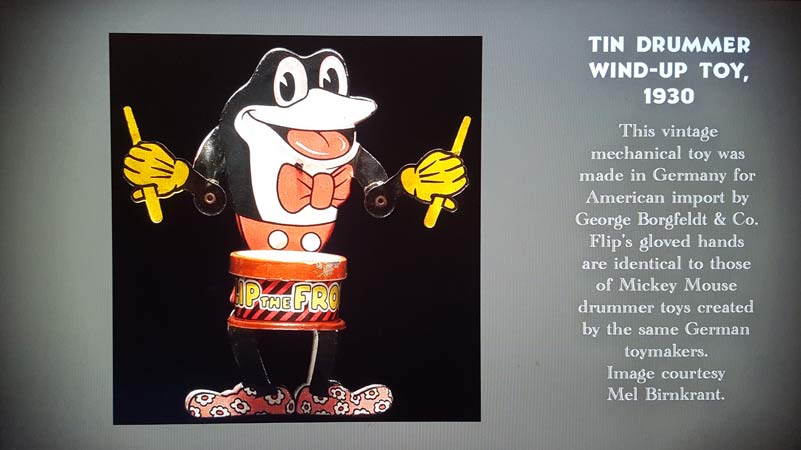
Foreign Titles (3:43) shows samples of titles used in French, German, and Dutch releases; and Reissue Titles (5:41) shows those from the Pat Powers/Celebrity Productions versions.
The Flip the Frog Coloring Book introduces the book, then provides 58 images from the 32-page edition.
The World of Flip the Frog is a comic book produced by a young David Gerstein in 1986 (years before he worked on official Disney comics), done with the permission of the Iwerks family. Contained in this feature are a comic story, a 30-second animation based on flipbook art by Gerstein (nice job, little Davey!), and excerpts from a live film screening (9:16), introduced by today’s David Gerstein.
Case Study:
The Blu-ray case holds a disc on either side. This set comes with a booklet with extensive liner notes written by animation historian and author J.B. Kaufman, valuably commenting on each cartoon. There are further writings there from Gerstein and Stanchfield, as well as notes on the music in the cartoons by Chris Buchman. My package also had a note inside, offering a replacement disc, due to an issue regarding accessing a couple of the commentary tracks on Disc 2 on some players, though they should be reachable regardless through the Audio button when selecting an individual cartoon. A surprise little thank you card from Flip completes the package.
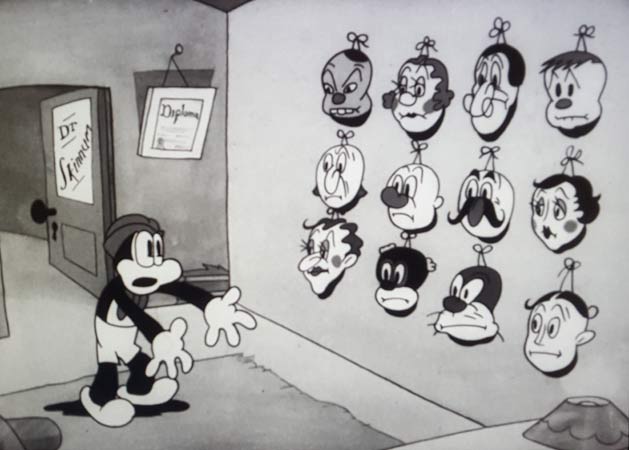
Ink And Paint:
Years in the making, and worth the wait! The shorts here look the best they have in decades, thanks to meticulous work from the Thunderbean crew. These shorts were never lost, as they appeared on home video all the way back to the Super 8 days of home film collecting. However, they didn’t look then like they look now on Blu-ray. Now, the shorts don’t exactly look like new, of course; some allowance must be given for the age of these films. Taken from original negatives and 35 mm fine grains, these shorts are, after all, over 90 years old. Plus, there are a few seconds here and there where obviously inferior materials had to be used to fill in the gaps. Still, the films are remarkably clean now, with good detail and a stable picture. There is some variation in density, some vertical lines occasionally running through the image, and almost subliminal flicker at times if you look for it. But that is all minor. Those that preordered will have the best opportunity to judge, as preorders also received discs containing the raw scans, but suffice to say that the immense amount of digital restoration has these films looking almost impossibly better.
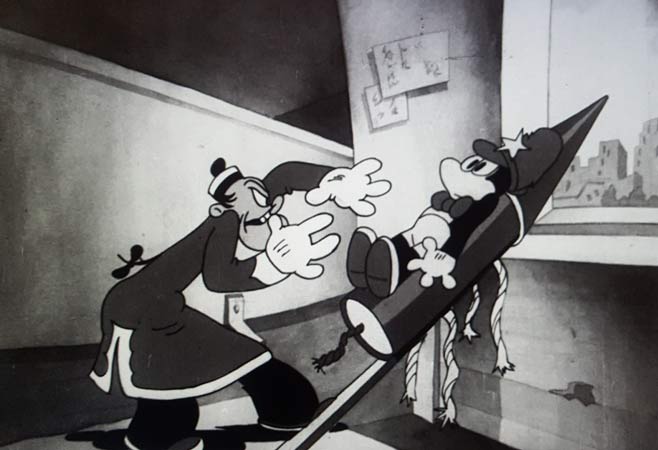
Note that the actual Blu-ray picture contains the entire frame image from the films, complete with rounded edges. I have cropped my images here.
Scratch Tracks:
The mono sound is very good as well. There is no significant distortion or hiss, allowing no auditory distractions when viewing the films. Note that Soda Squirt has a music and effects track option, as well as an option to play only the music

Final Cut:
This just may forever loom large as Thunderbean’s largest and greatest project. Years in the making (my preorder was dated July 15, 2016!), we now have all 38 Flip the Frog films from the 1930s, encompassing the entire filmography of Ub Iwerks’ own creation, digitally restored using the best available elements, most of which were original negatives. It won’t get better than this for Flip the Frog. He has never been treated so well, and Thunderbean’s assemblage of copious extras makes the set even better. This year is proving to be a great one for vintage animation fans, and certainly for Thunderbean.
 |  |







